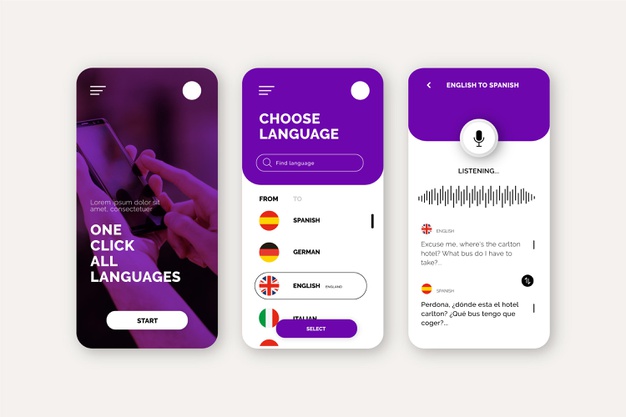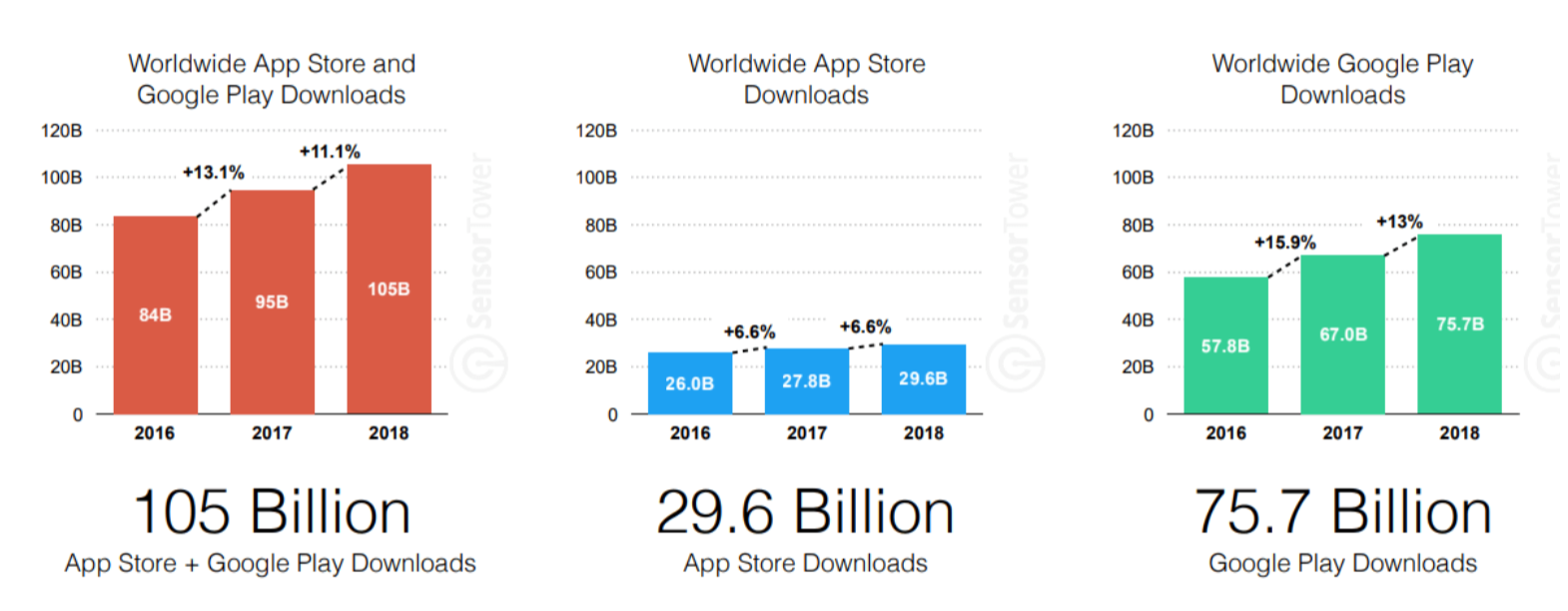The Importance of Translation and Localization in App Development and Sales
- Created at:
- Updated at:
The Importance of Translation and Localization in App Development and Sales
Depending on which reports you believe, app sales are projected to generate nearly 200 billion (yeah, Billion ... with a B) US dollars in sales in 2020. Add in the number of “freemium” apps. These apps are free but the end users can buy more features within the apps. Before long, these numbers start looking good to aspiring app developers.
There was an informative report posted on the BBC website in April of 2020 that reported some interesting statistics. There are more than 7000 official languages in the world today. Ninety-eight percent of all content on the internet is in only twelve languages.
Almost sixty percent of the information online is being written in English. Over eight percent of internet content is in Russian and a little more than four percent of internet content is in Spanish.
Wikipedia is the most diverse website in the world for language. Wikipedia has 307 different languages, but this is only a small margin of the total volume of content. More than eighty percent of all Wikipedia content comes from the United States or Europe.
How many app developers are missing out on the full potential of these foreign markets? How can you use translation and localization to put your apps in front of tens or hundreds of millions more potential users? How can you use translation and localization to reduce your competition?
What is Translation for App Development?
What is a translation for app development? The translation may refer to the computer languages and scripts used for applications. Though this should not be discounted, neither is it the focus of this article. The best computer languages for app development still need to consider many factors. Among these are the user interface and in some cases, the devices on which the applications will work.
Translation for app development refers to the ability of the application to function in different human languages for the user interface. From the point of the end-user, the app translations are rarely even considered. The concern, as a rule, is the ability of the user to use the app in their language.

Less than twenty percent of the population of the world speaks English, and the vast majority of them are not native speakers. It is also interesting to note that the largest English speaking nation in the world is the United States. What may be a surprise is that the statistics show that only about two hundred and eighty million of the US population speak English at all. There are more than three hundred and thirty million people in the United States. There are many people even in the United States that do not speak English at all.
After the US is India with about 125,000,000 English Speakers. Pakistan is third with almost 110,000,000 people speaking English. After this, we find Nigeria, the Philippines, and the United Kingdom, all having more than 50,000,000 English speakers. These are closely followed by Germany, Bangladesh, Canada, and Egypt with between 28,000,000 and 45,000,000 English speakers each.
All the English speaking people in the world make up less than twenty percent of the global population. Any app developed in English only dismisses some eighty percent of the world. This is not a profitable approach or even good business practice.
What is Localization for App Development
Translation and localization often go hand in hand. The translation services ensure that products and services are in a language that people can understand. Localization ensures that you are speaking to the heart of your audience. Learning how to find the right localization service requires an understanding of the marketers as both translation services and business localization are important in every aspect of their operations. For app development, localization services can be still more complicated.
What is localization for app development? Localization services for app development are more than nuanced language and local vernacular. Localization services for app development are part of virtually every stage of app development all the way through to the end-user.
Localization for app development takes into consideration all the potential devices that will be in use. Localization must also consider the software that runs these devices. There may be a need to consider power sources for charging if the app development is a “revolutionary” new smart device.
None of this gets into the realm of the user interface. The user interface must be wholly localized for the app development to become an international sensation. Color psychology is an important part of app localization and development. Language translations for the user interface are part of the localization process. There may also be a need for more localized linguistic variations beyond the translation.
The localization process is among the challenges when it comes to international and global app development. The question then becomes is the internationalization part of app development worth it for potential app sales?
The Importance of Translation in App Sales
What does app development translation have to do with app sales and marketing efforts?
The top 10 languages used on the internet together, encompass seventy-seven percent of all content online. Twenty-three percent of content is in languages whose grand total is less than 1 percent of all the content on the internet.
There are around 85 languages that have more than ten million native speakers. Even if only one percent of people in each of these markets were to buy your apps, that would be one hundred thousand potential new buyers in 85 markets.
How realistic are these numbers?
According to a host of available statistical data about apps available on the internet today, the answer would have to be an unequivocal yes. Mobile phone users spend an average of eighty-nine percent of the time using apps and only eleven percent of the time using mobile web access.
There is an increase in app sales for apps with integrated localization strategies and app translation. The average increase is 126 percent in total sales. That means that apps that are localized in the development stage average more than twice the number of sales of apps that have not been localized. Localization services implemented during app development also increase the average lifetime app income. The result is a twenty-six percent increase in profits on average.

The Importance of Translation and Localization in App Development and Marketing
There are more than two and one-half billion smartphone users in the world and almost one and one-half billion tablet users in the world today. The average smartphone user will check their phone every 12 minutes. Ten percent of smartphone users will check their phones every 4 minutes.
21 percent of millennials will open up an average of 50 apps per day on their mobile devices. One-half of all mobile device users will open up an average of eleven apps per day. The average smartphone user will have around thirty apps that they use every month. Fifty-seven percent of digital media is accessed using online apps. App development can indeed be a road to riches, but there is still a definitive need to access the target markets.
The markets are there for app development, but there should be no mistake about the intensity of competition. The Apple app store has more than two and one quarter million apps available for users to download. That is in itself an impressive number. The Google app store also has almost three million apps available for download. The rates of mobile device ownership are also pretty impressive.
China tops the list with more than eight hundred and fifty million mobile device owners. India is next with three hundred and fifty million mobile device users. The USA has roughly two hundred and sixty million mobile devices. After this, we begin moving below one hundred million mobile devices per nation.
Brazil has almost one hundred million mobile device users as does Russia. Indonesia is next on the list with over eighty million users. Next is Japan with more than seventy million mobile devices. Mexico and Germany have sixty-five million mobile users each. The last of the top ten is the United Kingdom with around fifty-five million mobile device users.
This is where we need to sit down and do a little bit of math to develop a marketing strategy for the apps. Also important is an effective means of marketing to new audiences with low levels of competition.
Spanish is one of the top languages on the internet with roughly 4 percent of the content online in Spanish. Much of this is going to be the Spanish language pages on Wikipedia, but there will still be a lot of competition.
Using business translation services to translate the marketing content into Spanish will help. Ninety-six percent of the online content will no longer compete in any way. How much easier should it be to rank on the top levels of the search engine results page with ninety-six percent of the competition gone?
Not enough yet?
Turn now, to the w3 website, which analyzes internet statistics and trends. There are only eleven languages that make up more than one percent of all internet content.
First, there is English with almost sixty percent. Next is Russian with eight and one-half percent. Then comes Spanish for about four percent. After that is Turkish with over three percent. Persian, German, and French all have only about three percent each. Japanese and Portuguese are down around two percent, and Chinese and Vietnamese are about one and one-half percent each.
Use the translation of marketing materials into any of the other languages in use today. This translation will immediately reduce competition by more than ninety-nine percent. Would it be easier to develop an app and sell it to a market where more than ninety-nine percent of the internet would not compete in any way?
Use translation services to capture any of the thousands of languages not listed in the top 11 languages. This reduction of competition is exactly what the result is for the app developers using translation.
This, of course, leads to the question of how app developers can establish a multilingual marketing campaign. The multilingual marketing campaign is necessary to capture high-value, under-marketed audiences.
Multilingual Marketing – Using Translation and Localization in App Development and Direct Sales
Nobody is suggesting any app developers avoid the English speaking markets. There is still an ample opportunity to expand beyond these markets. There is a need for multilingual marketing for international marketing success. At the same time, the app developer can reduce direct and even indirect competition. English language apps remain prevalent and should not be discounted, much less dismissed.
Multilingual Video Marketing – Video marketing is both extremely popular and effective. YouTube is the second most popular website on the internet and ripe with opportunity. Use video translation services to create the srt video closed captioning files in all the targeted languages.
The search engines will index the srt closed caption files for your videos. This increases the ranking as it adds to the number of keywords the video will rank for on the SERP. Given the reduction in competition, this means that you can better market your app. The larger audience should equate to larger sales with the proper marketing in place.
Do not use subtitles and closed captioning as this combination will reduce the views and interactions. The subtitles are hardcoded and always displayed only in a single language. Subtitles are also not indexed by the search engines.
The combination of subtitles and closed captioning will also interfere with the ability of the viewer to see the video. Closed captioning files added in different languages allow for a more interactive experience. The video translation then increases audience size.
Multilingual Social Media Marketing – Facebook has roughly two and one-half billion users and supports 111 languages. There are more than 140 languages in use on the Facebook platform at any given time. Twitter supports more than 35 languages making it a great location to promote apps. But even after attracting these viewers, there needs to be someplace for them to go. How can the user learn more about the apps and how to download them?
Website Translation and Localization – The idea of translating the entire website may or may not be an ideal solution. If the app has been localized for a particular area, there should be at least a landing page in the selected language. Chances are good that the app developers have elected to use app translations in many different languages. It may be enough to start with multilingual social media marketing and landing pages.
For an increased market share, as much information as possible is necessary to increase sales. This information then needs to be part of the website translation for new markets. This is all part of a complete website translation and multilingual marketing campaign.
As demonstrated here, translation and localization are not only an integral part of the app development. Translation and localization are also an important part of successful app marketing. Increased app visibility and decreased competitive markets serve to make the app development and the app itself, much more successful.
No additional information provided by user.
Popular posts
-
Avoid These 6 Mistakes In Mobile Push Notification Designing
- 2
- 0
-
Commonly Used Packages and Plugins in Flutter
- 3
- 0
-
Challenges of adapting blockchain to the Internet of Things
- 0
- 0
-
How to Optimize Your JavaScript App?
- 4
- 0
-
Who should be held responsible for a customer data breach?
- 0
- 0
-
The Importance of Translation and Localization in App Development and Sales
- 1
- 0
